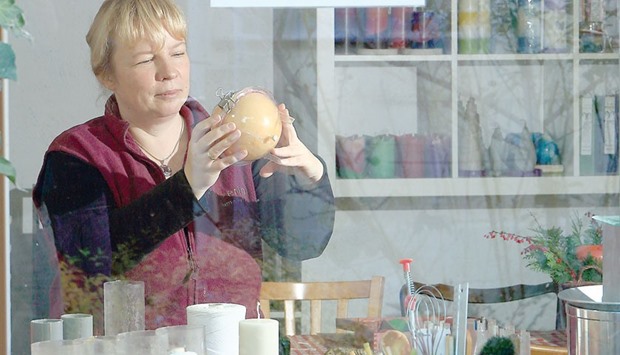With practiced movements, Katrin Fahle dunks the nearly complete candles into a metal container for just a few seconds.
“It gives the candles a thin outer coating of wax and that top layer protects the decorations,” she explains. “You need a steady hand and no distractions for this step, it doesn’t always work.”
But this time Fahle is pleased with her efforts.
Germans love gorgeously decorated candles, whether as gifts for other people or just to spoil themselves, believing that a flickering flame on a wick in a darkened room is a sure-fire way to induce peace and contentment.
Only a candle-lit dinner can be romantic. Electric light is strictly for German business dinners.
The 41-year-old, who studied German literature at university, turned to artisanal candlemaking five years ago.
“But actually I started 15 years earlier.” Back then, on a cheerless, rainy day, she decided to start making candles with her niece for fun.
At first they used disposable plastic yoghurt pots to shape the wax — a big mistake. The hot wax melted the yoghurt pots within seconds. But Fahle didn’t give up.
“I told myself, there has to be a better way.” And without knowing, she’d already made the first step towards her new profession.
From then on, she began experimenting, seeking guidance from experts and specialist literature, learning to make candles in unusual shapes and exotic colours that get sold as little sculptures that slowly vanish as they give up their light.
“Wax is my material,” she says now. She knows, for example, that the optimum temperature for pouring wax is 56 to 90 degrees Celsius.
And she now has her own workshop next to her home in Goednitz, in the eastern German town of Zerbst, set up according to her wants and needs.
Wax can be used to create all kinds of different candles, though Fahle draws the line at some things.
“I don’t make scented candles. And I always choose the shape so that the candle burns for as long as possible,” she says.
She also refuses to make candles with portraits on them, saying she finds the idea that the face melts down along with the candle rather tasteless.
Her floating candles are particularly popular. They have a decorative weight which helps them stay upright in water.
Her christening candles, which she decorates with footprint of the child in question, are also in demand for Christian baptisms. Most of her orders come via the Internet, including from Germany’s neighbour Austria.
In total, she uses up around 750 kilograms of wax every year.
“I’m always on the lookout for new, original ideas,” she says. “My main season isn’t winter but rather between May and August.”
When she’s not making and selling her own candles, she also offers workshops for adults and children and has a stall at some weekly and Christmas markets.
“For me making candles is a unique way of communicating with people. It gives people pleasure and the fact that I can make a living from it gives me an ego boost,” she says.
In Germany’s guild of candlemakers, she’s the only one registered in the whole of the state of Saxony-Anhalt. It’s a dwindling trade. Most candles used nowadays are churned out by big factories.
“There are 78 candlemakers in Germany registered with us,” says Wolfgang Reich, director of Bavaria’s candlemakers guild in Stadtbergen, which now represents candlemakers across the country.
“There are probably more of them though, because for years it’s no longer been obligatory to register with us,” he adds.
That means that anyone can legally make candles without having to pass an examination in specialist knowledge.
But the profession of “candlemaker and wax sculptor,” with its three-year apprenticeship, still exists in Germany’s thicket of professional laws and rules.
“We’re still training people and it’s great that young people, particularly women, are interested in it,” says Reich. —DPA

AT WORK: Katrin Fahle, 41, checks a spherical candle in her workshop in Goednitz, Germany.


